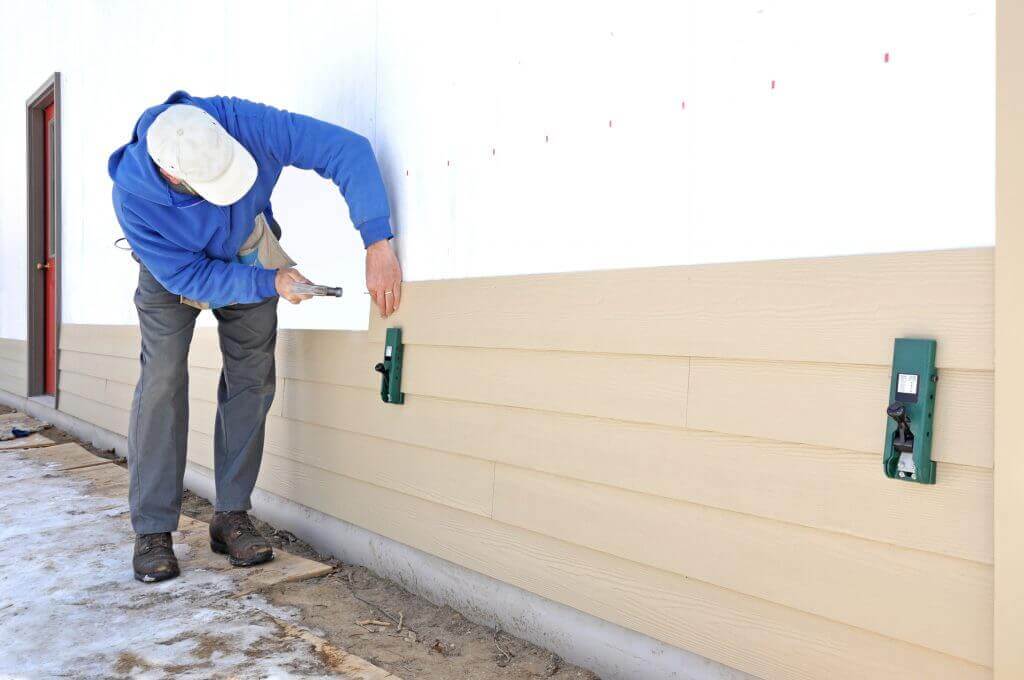Are you doing a siding project?
Modernize can pair you with three to four pros in your area, so you can compare options and save time and money.
Vinyl siding is one of the easiest types of siding to install, but that doesn’t mean it doesn’t require skill or knowledge to complete properly. When incorrectly installed, vinyl siding will let water in, and it will become a lovely home for all sorts of pests—which won’t look very good either. Here are some tips to help you avoid the most common mistakes during vinyl siding installation.

Consider a Wider Starting Strip
There are several options of starter strips available for starting vinyl siding. Most people are inclined to use the thinner starter to get things going because it’s more affordable—but this is a bad move. Spend the extra money and invest in a 3-1/2″ starter strip. During your installation, make sure that at least 1″ of the starter strip hangs down over the top of the foundation of the house, and drop it down as low as you can while installing the strip properly.
The more that the foundation is covered by the starter strip, the better the siding is going to protect the house against rain, snow, and anything else that nature throws at it.
Level it Out Carefully
Properly installed siding needs to be leveled. Not only will it function better if it’s all leveled out, but it will go on more easily as well. When you first get going with the project, snap a level chalk line all around the base of your home where the first run of siding will go. This is to help get your installation straight. Then throughout your project, take the time to level things out about once every five courses to keep things going properly.
Leave Space on the Ends
Vinyl siding has to be able to move just slightly after it’s installed. For that reason, it’s important to cut your end pieces so that you have a total of ¼” of extra space together on both ends of your siding runs. This is to help with expansion during the summer months, to keep your siding from buckling and having other nasty problems along the way.
Find the Right Contractor for Your Siding Project
Whether you’re ready to begin your project now or need some expert advice, our network of contractors are here to help. With a few simple questions, we’ll find the best local professionals for you
Use a Vinyl Blade to Make the Cuts
Don’t try using a standard fine-toothed saw blade to cut your vinyl sections during vinyl siding installation. Instead, rely on a specialty vinyl blade. The blade arranges the teeth backward so that the cut is smoother. This cuts down on chipping and other issues during standard cutting and makes the project go much more effectively overall. If you need help installing vinyl siding, Modernize has tons of reliable local vinyl siding installers waiting to talk to you today.
Lock Siding Down Loosely
You mustn’t lock the siding tightly against the walls of the house. Instead, you should leave a gap between the head of the nails and the siding being locked down underneath them. This will allow the siding to move properly as it expands and contracts.
Lift and Nail
The last thing you want is for your siding to come apart after it has been installed. That’s why you should pull each piece up slightly as you are nailing it. As you go along, lift up the piece and then nail it into place. This helps to securely lock the pieces together and to create a sturdy bond between the sections of the siding.
Choose the Proper Nails
Select galvanized roofing nails to hold the siding firmly in place and to stand up to weather properly after the siding is installed. Make sure that they are at least two inches in length, but use longer nails if the siding is going over top of rigid foam instead of right up against sheathing. Make sure that the nails are galvanized or the weather will corrode them much faster than it should and you’ll be left with siding falling off your home.
Flash Window Bottoms
Before starting vinyl siding installation, flash the bottom corners of each window. Cut felt paper to fit over the window corner and secure it with roofing nails. This step prevents water from seeping behind the J channels, protecting the window framing. Water will roll down the flashing and out over the siding below. Ensure the flashing extends over the siding runs beneath it for proper drainage.
Following these tips improves results, reduces installation time, and enhances the final look. If you prefer not to DIY, we can connect you with local pros.
Find the Right Contractor for Your Siding Project
Whether you’re ready to begin your project now or need some expert advice, our network of contractors are here to help. With a few simple questions, we’ll find the best local professionals for you
Reviews from Real Homeowners
Welcome to Homeowner Resources! We are the Modernize blog. Modernize pairs more than 3 million homeowners a year with pre-vetted contractors in their area. This blog started because we believe homeowners should know everything about their homes, from how their HVAC works to which front door colors they might love. On Homeowner Resources, you can find information on every part of your home, right down to how you can negotiate with contractors to get the best price. Here's more about the blog.
Need a contractor? Learn more about how Modernize finds the right pro for you.





